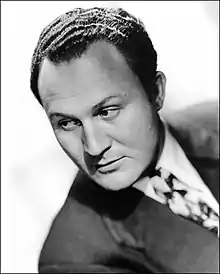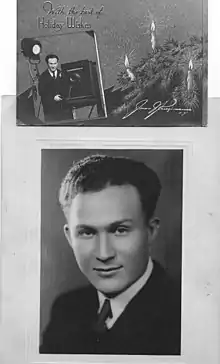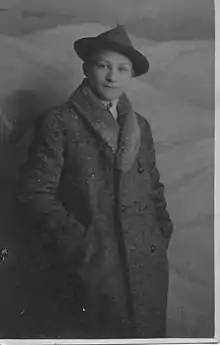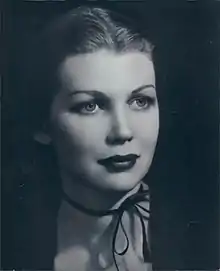James J. Kriegsmann
James J. Kriegsmann (1 January 1909 – 29 April 1994) was a celebrity and theatrical photographer who worked from 1929 to the early 1960s.


| James J. Kriegsmann | |
|---|---|
 | |
| Died | 29 April 1994 |
| Occupation | Photographer |
Early life and education

Kriegsmann was born on 1 January 1909, in Sadagóra, Bukowina, Austria and later moved to Vienna. His father was a shoemaker named Louis "Lui" Kriegsman, born 11 March 1883, in Chernowitz, Bukovina, Austria who left for New York City on the S.S. Mount Clinton from Hamburg on 6 September 1923. He studied classical violin and mandolin as an adolescent and later apprenticed with photographers in Vienna before leaving for New York at age 20 following the death of his mother Fannie Kriegsman in 1929. He and his younger siblings Josef, Etelka and Rose left for New York via Hamburg on the S.S. St Louis on 20 September 1929, with little to no ability to speak English.
"his talents put him in a class with three of the most prominent celebrity shutterbugs in America at that time, including Tony Bruno, a Hollywood photographer who moved to New York and set up shop in Carnegie Hall; Maurice Seymour, who was based in Chicago and would later work for Kriegsmann in his New York Studio; and the legendary George Hurrell, who took classic portraits of stars like Joan Crawford, Jean Harlow and Marlene Dietrich during Hollywood’s golden era." —The New York Times, 2010[1]
Career
Photography
Opening his New York City studio on 1933, James J. Kriegsmann was famous for his portraits and publicity shots of celebrities from the 1930s thru the 1960s. Kriegsmann's first celebrity photographs were taken when the Flying Wallendas visited the studio where he was employed, and he was the only employee able to speak with them in their own language. Karl Wallenda and Kriegsmann would become lifelong friends.[2]
Kriegsmann photographed many Motown notables, as well as Bill "Mr. Bojangles" Robinson, Florence Ballard, Cab Calloway, Frank Sinatra (also with daughter Nancy on his knee), Ray Conniff, Bill Haley, Sid Caesar, Benny Goodman, Ray Charles, Martha Raye, Doris Day, Milton Berle, Duke Ellington, Smokey Robinson, "Little" Stevie Wonder, Tom & Jerry (later Simon and Garfunkel), and hundreds more.[3]
His studio occupied a former Hungarian restaurant in the first floor of the Actors’ Equity Building at 165 West 46th Street, New York City, and operated for over 60 years in partnership with his two sons, noted photographers James J. Kriegsmann Jr. and Thomas O. Kriegsmann. In its time the studio was the largest headshot photography studio in the world.
Kriegsmann became the official in-house photographer for Harlem's Cotton Club,[4] and he was considered among the best photographers in America, who at that time included Murray Korman, one of Broadway's most prolific photographers; Tony Bruno, a Hollywood photographer who relocated to New York City and worked from his studio in Carnegie Hall; Chicago's Maurice Seymour who eventually joined Kriegsmann in his New York studio and photographed alongside him for many years; and the legendary George Hurrell of Hollywood.[5]
“If you look at the [Kriegsmann Studios] clientele over the years, it’s obvious that the black community thought very highly of [James J. Kriegsmann] as a person, and as a professional, way back then," Mr. Lee said. "The thinking among them was probably, ‘Hey, this cat is cool, let him take your picture, spread the word.’ ”
Slide Hampton, 78, a two-time Grammy-winning trombonist who once had his picture taken in the old Times Square studio, said of Kriegsmann: “What he did for black entertainers was very noble. After all these years, the fact that some black stars are still working with his son as a way of paying homage to his father is just as noble.”[1] A number of Kriegsmann's photographs can be seen on display in the galleries of the Hebrew Home for the Aged in Bronx, NY.
Music
In addition to his work as a photographer to the stars, Kriegsmann wrote hundreds of songs for top recording artists of the day,[6] including the hit "The Happy Organ" for Dave "Baby" Cortez, which was the first instrumental song to reach number one on the Top 100 Billboard charts, in 1959, and has been featured in many films.
Personal life

In 1940, Kriegsmann hired Brooklyn-born Eugenie "Genie" Conran, a beautiful young woman of 17, who, along with a number of other glamorous and older women, had responded to an ad for a receptionist for his studio. She worked at that position until the studio's closing in 1988. They were married on 2 October 1940, when she was 18, and had three sons. They lived in Forest Hills Gardens in Forest Hills, Queens.
References
- Mallozzi, Vincent M. “Behind the Lens, Continuing a Legacy” New York Times 10 January 2010
- Janis Bultman, "James J. Kriegsmann", Darkroom Photography,, 1984.
- New York Times, “James J. Kriegsmann; Theatrical Photographer, 85”, 1 May 1994
- Shout, sister, shout!: the untold story of rock-and-roll trailblazer Sister Rosetta Tharpe Gayle Wald, Beacon Press, 28 February 2007
- Vivien Raynor, “Art; From the Famous to the Nameless” New York Times, 14 June 1998
- Jennifer Sharpe. "Dumpster of Forgotten Musicians Launches Quest" NPR, 2 November 2007